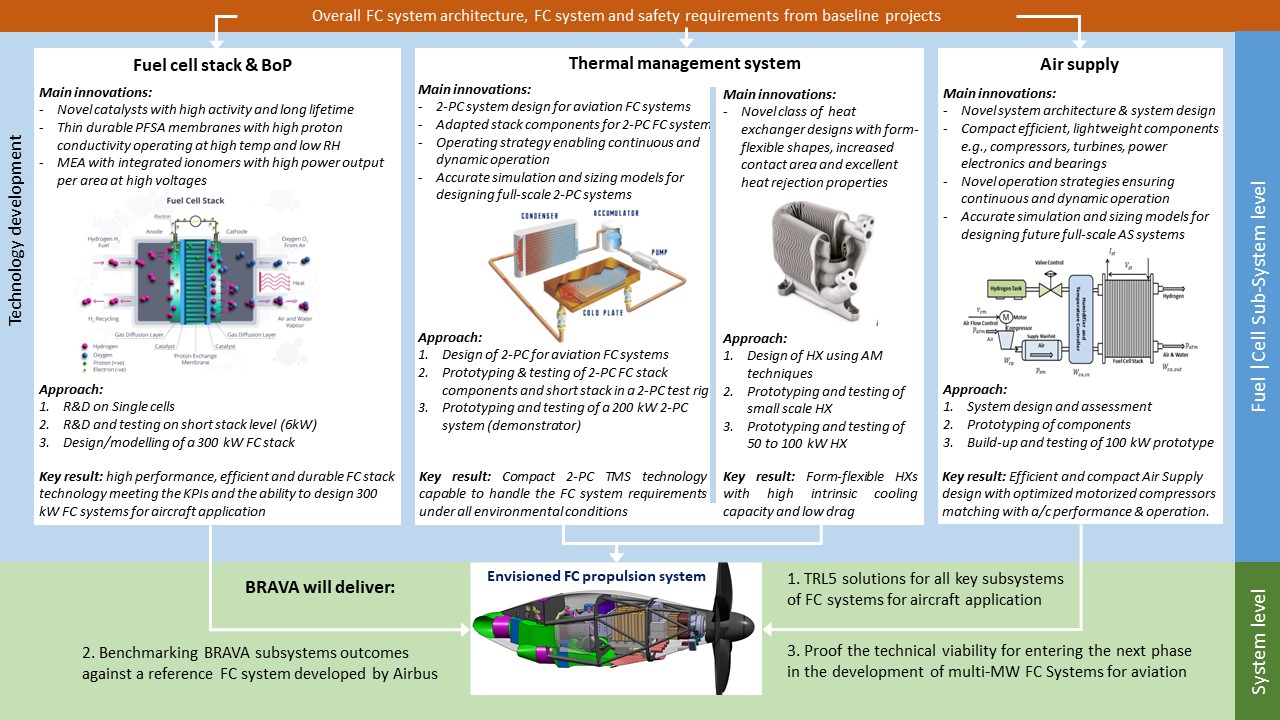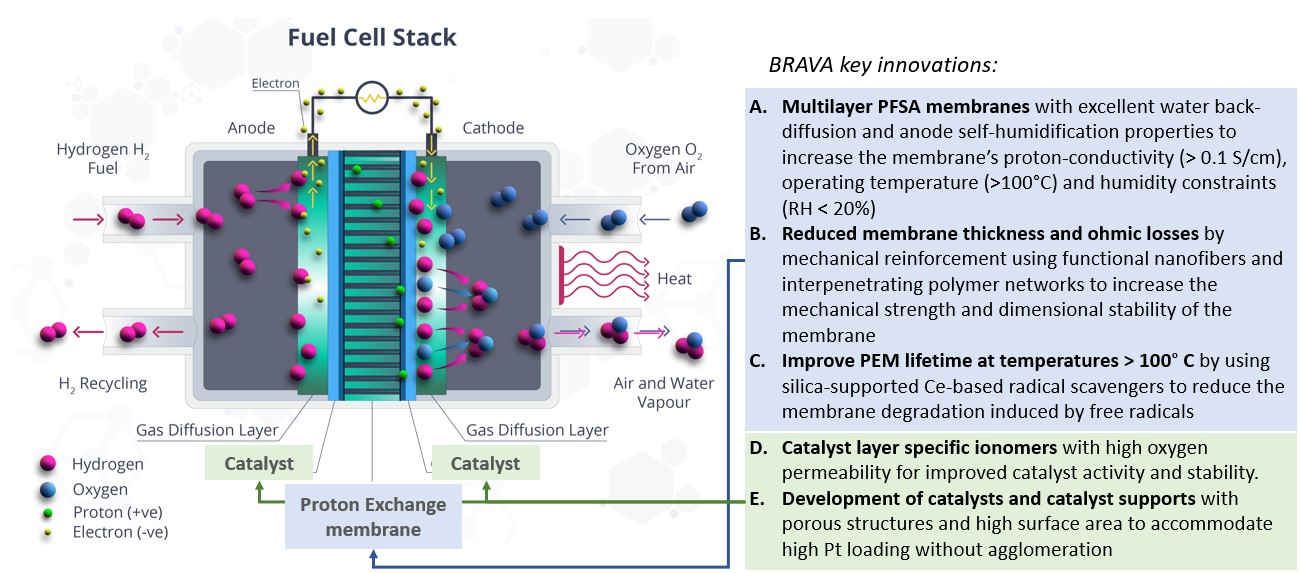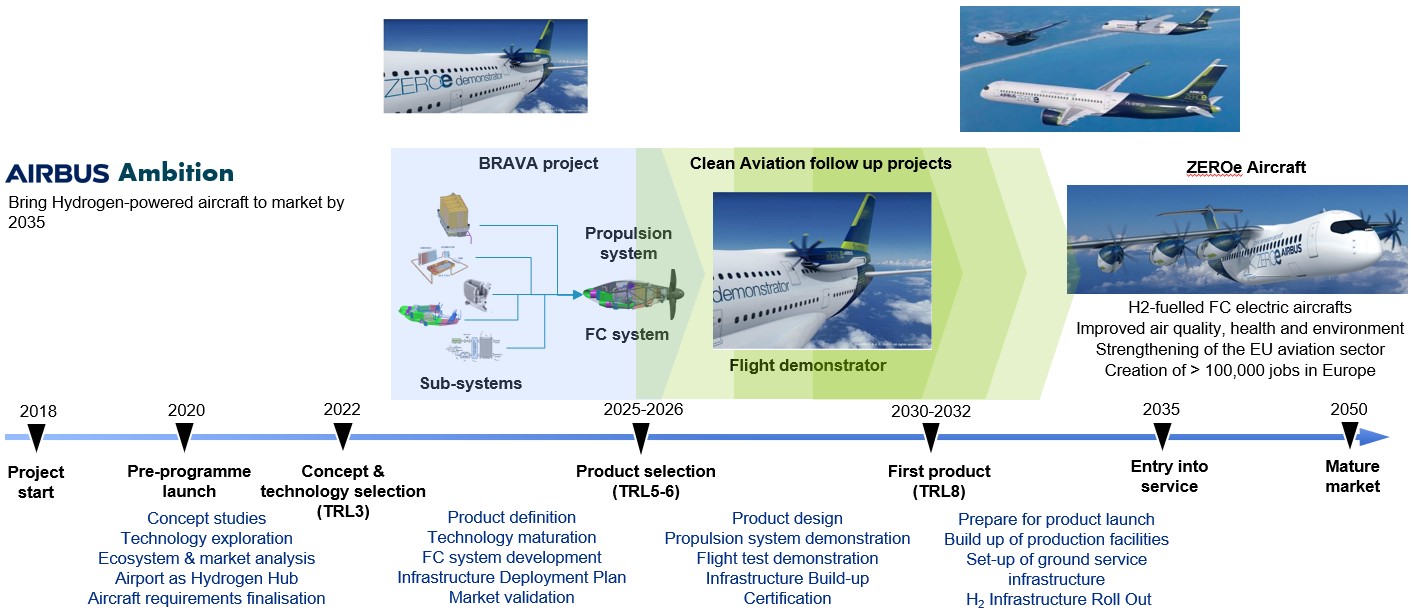BRAVA project
Introducing the Future of Aviation Power: Unlocking the Potential of PEM Fuel Cells
About BRAVA
The world of aviation is on the verge of a revolutionary transformation, thanks to the ground-breaking Proton Exchange Membrane (PEM) Fuel Cell (FC) technology. While PEM FC systems have already made their mark in the automotive industry, their true potential for the aeronautic sector is only just beginning to be realised. Imagine aircraft soaring through the skies with unprecedented power, efficiency, and reliability, all while adhering to the stringent safety standards of the aviation industry.
Enter BRAVA – the driving force behind the development of a game-changing Fuel Cell-based Power Generation System (PGS) for aviation. Our mission is clear: to create a high-performance PGS capable of delivering an astounding power range exceeding 2 MW. This visionary multi-MW system will serve as the backbone of next-generation aircraft propulsion, paving the way for exciting possibilities. In fact, Airbus envisions a future where a number of multi-MW FC-based PGSs propel an aircraft that can effortlessly carry up to 100 passengers across distances of up to 1,000 nautical miles.
At the heart of BRAVA’s innovation lies a relentless pursuit of excellence in every aspect. We are revolutionising the FC stack and balance of plant (BoP) components, reimagining the thermal management system (TMS), perfecting heat exchanger design and technology, and even reshaping the architecture of the air supply system. These innovative advancements serve as the very building blocks for our multi-MW FC-based PGS, igniting a new era of aviation power.
Follow us on this extraordinary journey via this website as we unlock the full potential of PEM FCs in aviation. Together, we will reshape the future of flight, ushering in an era of unparalleled power, sustainability, and limitless possibilities in the skies. Experience the thrill of innovation with BRAVA and be a part of the aviation revolution.
Objectives
Defining Fuel-cell based Power Generation system architecture and safety requirements based on the higher-level FC propulsion system requirements (considering balance of weight)
Designing, developing, testing and validating 2-phase cooling system for Fuel cell stack
Designing, developing, testing and validating compact and form-flexible (air to liquid) heat exchangers via Additive manufacturing
Developing, optimising, testing and validating a high-performance FC stack
Developing, testing and validating an air supply subsystem for FC system for aviation
Design a FC power generation system with high efficiency and high gravimetric power density compatible with aeronautical specifications and constraints based on integration of developed subsystems.
Concept
Unleashing the Power of BRAVA: Advancing the Future of Aviation
BRAVA is not just a concept; it’s a bold vision that will shape the future of aviation. Our approach is clear: to deliver exceptional results and realise our objectives. Throughout the implementation of this project, our focus will be on developing and testing game-changing technologies for each subsystem, ensuring unparalleled performance and reliability.
The core subsystems under scrutiny include the FC stack, along with its crafted Balance of Plant (BoP) components. Additionally, we will push the boundaries of innovation with the Thermal Management System (TMS), comprising the cutting-edge 2-PC system and the advanced AM-HX. The Air Supply system will also undergo extensive research and development. These subsystems will be meticulously validated on individual level before integration into a future FC propulsion system after the project, while setting new standards for aviation.
Every step of the way, we are committed to meet and exceed a multitude of requirements at various levels from the specific aircraft specifications, including engine requirements and design for regional aircraft, to the comprehensive system specifications for the Power Generation System (PGS). Each subsystem and component will undergo rigorous testing and manufacturing, ensuring they meet the highest standards set forth in WP3-WP5.
To guarantee that our defined criteria are met, every subsystem will undergo rigorous testing at both component and subsystem level. We will evaluate the performance of the BRAVA system against a reference FC system architecture, utilising baseline technology components sourced from the automotive FC systems (TRL 8-9). Our commitment to excellence and advancement is unwavering as we forge a new path in aviation.
Approach
Accelerating Progress: BRAVA’s Path to Innovation
In our pursuit of excellence, we will utilise a reference system—a robust MW FC Power Generation System (PGS)—developed, constructed, and tested independently from the BRAVA project. This reference system will serve as the benchmark against which we measure our progress and accomplishments in subsystem development. By surpassing the achievements of the reference subsystems and meeting the required key performance indicators (KPIs) defined at an early stage of the project BRAVA will position itself for an unprecedented follow-up project, such as in the Clean Aviation Programme Phase 2.
The follow-up project will focus on the development of an integrated FC propulsion system, encompassing both ground and flight testing. This ambitious endeavour will elevate the product specifications and performance of future aviation PGS to unprecedented heights. The result will be a revolutionary FC system designed specifically for aviation applications, paving the way for a new era of high-performance, decarbonised flight via Hydrogen-fuelled FC technology.
However, within the scope of BRAVA, we will embark on a preliminary design phase, conceptualising a complete PGS that seamlessly integrates the various subsystems. While the project’s focus remains on subsystem-level advancements, we acknowledge that further integration into the Power Propulsion System (PPS) and eventual aircraft-level integration lie outside the project’s immediate purview.
To provide you with a deeper understanding of our approach, we will now delve into the underlying concepts, models, assumptions, and methodologies for the FC stack that forms the bedrock of our project. These elements work in harmony with developments on the other subsystems Air supply and thermal management system to ensure the realisation of overall BRAVA’s objectives.
Results
Revolutionising FC Systems for Aviation: BRAVA’s Breakthrough Technologies
In the ever-evolving landscape of civil aviation, off-the-shelf FC technologies have fallen short of meeting the demanding targets set for propulsion systems in crucial markets. Recognising this challenge, BRAVA takes centre stage by spearheading the development of cutting-edge breakthrough technologies specifically designed for aviation, harnessing the power of the Proton Exchange Membrane Fuel Cell (PEMFC) principle.
Within BRAVA, the FC subsystems will deliver a range of pivotal project results, revolutionising the future of aviation:
- 2-PC based TMS: Our pioneering Thermal Management System (TMS) embraces a 2-PC design, incorporating a newly engineered FC-stack. By prioritising compactness and weight reduction, we aim to significantly minimise fuel consumption and maximise efficiency.
- AM HX: We introduce the Advanced Heat Exchanger (AM HX) technology, optimising heat rejection while ensuring seamless integration, reduced weight, and minimal aerodynamic drag. This breakthrough innovation contributes to enhanced performance and fuel efficiency.
- Advanced Stack Cell Catalysts and Membranes: BRAVA pushes the boundaries of stack cell catalysts and membranes, unlocking higher levels of performance, durability, and operational temperature capabilities. These advancements facilitate the integration of new Membrane Electrode Assemblies (MEAs) that deliver unparalleled efficiency, compactness, reduced weight, and extended lifetimes.
- Innovative Air Supply Architecture: Our team has meticulously designed and optimised a state-of-the-art air supply architecture, bolstered by components specifically tailored for aviation requirements. This forward-thinking approach minimises parasitic power, reduces weight, and ultimately lowers fuel consumption and equipment costs.
- Optimised FC System Architecture: Embracing a holistic approach, BRAVA presents an optimised FC system architecture that encompasses innovative concepts such as anode and cathode path recirculation. These advancements promote compactness, lightweight design, and elevated operational reliability, propelling aviation power systems to new heights.
With these breakthrough technologies at the core of our mission, BRAVA is set to redefine the possibilities of FC systems in aviation. Join us as we revolutionise the skies and pave the way for a hydrogen-fuelled electric, efficient, and high-performing future of flight.
Facts and figures
- Acronym: BRAVA
- Duration: 3 years
- Start date: 1st of December 2022
- Total budget: € 19,986,841.75
- EC funding: € 19,986,841.75
Publications
This section will be filled during the project with scientific publications and references to relevant ZEROe communications.



